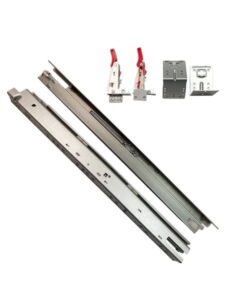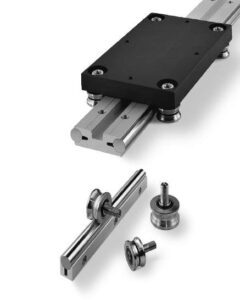1. Introduction to Linear Guide Shafts
2. How Does a Linear Guide Shaft Work?
Shaft (Guide Rail):A hardened, precision-ground steel rod that serves as the linear motion path. Bearing/Bushing:A sleeve or rolling element (ball or roller) that slides or rolls along the shaft, reducing friction. Carriage (Optional):A housing that holds the bearing and attaches to the moving part of the machine.
3. Types of Linear Guide Shafts
(1) Material Types
Chrome-Plated Steel (Most Common):Offers good hardness, wear resistance, and corrosion protection. Stainless Steel:Ideal for harsh environments (food processing, medical) due to corrosion resistance. Aluminum or Carbon Fiber (Lightweight Applications):Used where weight reduction is critical.
(2) Precision Grades
Standard Precision:Suitable for general automation and light-duty applications. High Precision (H-grade):Used in CNC machines and high-accuracy equipment. Super Precision (P-grade):For ultra-fine positioning (semiconductor manufacturing).
(3) Bearing Compatibility
Linear Ball Bearings (Rolling Elements):Provide low friction and high speed. Linear Bushings (Sleeve Bearings):Sliding motion, simpler design, lower cost. Linear Roller Bearings (Heavy Loads):Best for high-load applications.
4. Key Applications of Linear Guide Shafts
5. Advantages of Linear Guide Shafts
6. Disadvantages & Limitations
7. How to Select the Right Linear Guide Shaft
Load Requirements(Radial, Axial, Moment Loads) Travel Length & Speed Environmental Conditions(Corrosion, Dust, Temperature) Precision Needs(Standard vs. High Precision) Bearing Type(Ball, Bushing, or Roller)
Shaft Diameter(6mm to 50mm+ common) Shaft Length(Customizable based on application) Surface Hardness(HRC 58-62 for durability) Straightness Tolerance(±0.01mm/m for high precision)
8. Installation & Maintenance Tips
Installation Best Practices
Ensure Proper Alignment– Use a straightedge or laser alignment tool. Preload Bearings (if applicable)– Reduces play and improves stiffness. Secure Mounting– Use rigid brackets to prevent vibration.
Maintenance Guidelines
Regular Lubrication(Oil or Grease, depending on bearing type) Inspect for Wear & Misalignment– Check for scoring or binding. Clean Dust & Debris– Prevents abrasive wear. Replace Worn Shafts/Bearings– Avoid system failure.
9. Linear Guide Shaft vs. Linear Rail: What’s the Difference?
10. Conclusion: Why Linear Guide Shafts Matter
wang, tingting



